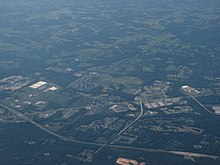Exurb


An exurb is an area outside the typically denser inner suburban area of a metropolitan area, which has an economic and commuting connection to the metro area, low housing density, and growth. Confusingly, the term "exurb" was used starting in the 1950s as a synonym for a commuter town, as the word exurb (a portmanteau of "extra & urban") was coined by Auguste Comte Spectorsky, in his 1955 book The Exurbanites, to describe the ring of prosperous communities beyond the suburbs that are commuter towns for an urban area.[1] However, especially since a landmark report by the Brookings Institute in 2006, the term is generally used for areas beyond suburbs and specifically less densely built than the suburbs to which the exurbs' residents commute.[2]
Definition
According to the Brookings Institute (2006), to qualify as exurban, a census tract must meet all three of the criteria described below.[2]
- Economic connection to a large metropolis.
- Low housing density: bottom third of census tracts with regard to housing density. In 2000, this was a maximum of 2.6 acres (11,000 m2) per resident.
- Population growth exceeding the average for its metropolitan area.
Exurban areas incorporate a mix of rural development (e.g. farms and open space) and in places, suburban-style development (e.g. tracts of single-family homes, though usually on large lots). In long-settled areas such as the U.S. Northeast megalopolis, exurban areas incorporate pre-existing towns, villages and smaller cities, as well as strips of older single-family homes built along pre-existing roads that connected the older population centers of what was once a rural area.
Examples
Examples of exurban areas in the U.S.:
- Cartersville, Peachtree City, McDonough, outside Atlanta, Georgia
- Castle Rock, Colorado, outside Denver, Colorado
- Conroe, Texas outside Houston
- Forsyth County, Georgia, outside Atlanta
- Hunterdon, Monmouth, Morris, Ocean, and Somerset counties in New Jersey are all exurbs of New York City.
- Lancaster, California and Ventura County outside Los Angeles, California
- Litchfield and New Haven Counties in Connecticut are all exurbs of New York City.
- Loudoun County, Virginia, outside Washington, D.C.
- DeKalb, southern Kendall, Grundy, and northern McHenry Counties, near Chicago, Illinois
- Olathe, Kansas, outside Kansas City, Missouri
- De Soto, Kansas, outside Kansas City, Missouri
- Orange[3], Putnam and Dutchess[4] counties, outside New York City
- Ozaukee County, outside Milwaukee, Wisconsin
- Pinal County, Arizona between Phoenix and Tucson, Arizona
- Pine City, Minnesota outside Minneapolis[5]
- Rochester, Michigan, outside Detroit, Michigan
- Northern Marin County, Napa County, Eastern Solano County, Sonoma County, outside San Francisco Bay Area
- St. Croix County, Wisconsin, outside Minneapolis, Minnesota
- Saint Francois County and Saint Charles County, outside St. Louis
- Stow, Massachusetts outside Boston
- Temecula, California, outside Riverside and San Diego, California
- Weston, Homestead, Jupiter outside Miami/Fort Lauderdale, Florida
- Spring Hill, Plant City, Ruskin, outside Tampa
- Williamson County, outside Nashville, Tennessee
- Glenpool, Oklahoma south of Tulsa
- McKinney, Texas north of Dallas
- Ikorodu outside Lagos, Nigeria
References
- ^ Spectorsky, Auguste C. (1955). The Exurbanites. Lippincott, Philadelphia: J. B. Lippincott & Co. OCLC 476943.
- ^ a b Berube, Alan (2006). Finding Exurbia: America’s Fast-Growing Communities at the Metropolitan Fringe (PDF). Brookings Institution. Retrieved 26 June 2019.
- ^ "There and Back Again". The New Yorker. April 16, 2007.
- ^ "Exurbia" (PDF). Brookings.edu. June 2016.
- ^ Gainor, Mike. "Study: Pine County workers have 5th longest commute". pinecitymn.com.
